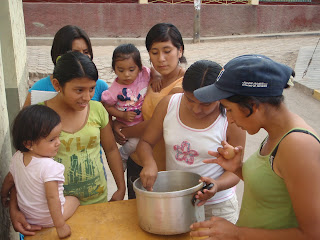
As I reminisce on Thanksgiving holidays spent at home, familiarity is at the core of these family celebrations. During all the Thanksgivings I celebrated in the US, I was always surrounded by familiar foods, familiar faces, familiar places, even familiar tastes and smells. This familiarity marked the essence of the holiday for me, a sense of comfort flooding my body as I breathed in the scent of baking pumpkin pie. Just like everything else in the past year and a half, these past two Thanksgiving holidays have been different. Different, as I found out, can be a very good thing. Although I value the familiarity of home and the importance of tradition, the two Thanksgivings I’ve spent in Peru have been among the most memorable. Although I associate the holiday with familiarity, its foundations were surely quite different. I think the basis of Thanksgiving developed through the union and fusion of different cultures, different customs, and different traditions. As the pilgrims and Indians sat down at their supposed feast, I doubt the dual cultures and new smells evoked any deep seated sense of comfort or familiarity. I imagine it was in the discovering of each other’s potentially bizarre language, customs, and foods that made the event a legendary day of sharing that we continue to commemorate today.
Last year, after spending only three short months in my new Peruvian home of Poroto, I remember being extremely excited to reunite with my Peace Corps volunteer friends. Although being far from friends and family for Thanksgiving was different, we managed to create a little piece of America in the depths of the Andes Mountains in Ancash. This epic Thanksgiving celebrated with glacial lake hikes and high altitude turkey-trot races set a high bar for my Peruvian Thanksgiving expectations.
This year, we decided to bring Thanksgiving to the beach, and celebrated in Puerto Malabrigo, the site of the world’s largest left wave. Peace Corps volunteers traveled from near and far to reunite and celebrate together. We enjoyed the sunshine and spent the weekend preparing enormous pots of food. Each person brought their favorite family recipes to prepare and share; sweet potato biscuits, homemade stuffing, garlic green beans, pumpkin pie, banana pudding, ginger broccoli, chocolate cake, homemade applesauce, spicy cornbread, apple pie and more. Chris and Ellen even brought their pet turkey all the way from Cajamarca, which they’ve been raising since last year to serve as the focal point of this important meal.
Our Thanksgiving day began bright and early with a turkey trot 5K race. We all donned our matching red “Hang-5K” t-shirts and headed to the beach to work up an appetite for the afternoon feast. Although winner received a free surf lesson, everyone enjoyed participating in this memorable Thanksgiving event.



As most people know, I adore my Peruvian host family, so I naturally wanted them to join us in Puerto Malabrigo for this holiday celebration. I had been nagging them for weeks, raving about the enormous platters of delicious food and beautiful location of this year’s Thanksgiving, but as usual they wouldn’t commit 100% to coming. When they called to tell me they were on their way to join in the festivities I was quite excited (I think Joshy was won over when I told her 30+ gringos would be in attendance). We spent some time soaking up sunshine and frolicking in the waves, and then commenced the chaotic cooking frenzy.


After a weekend of cooking we sat down at a table that seemed to stretch out forever, filled with Peace Corps volunteers, host families, and other local community members. As different people stood to give “palabras” or toasts for the holiday, I found myself overwhelmed with emotion. With my host family by my side, delicious food on my plate, and friends filling the room, I’ve realized that familiarity isn’t found by simple repetition of the same people, the same places, or even the same foods, but rather by embracing the circumstances you’re given and creating something new and beautiful.


 Thanksgiving leftovers on the beach... that is a tradition I could get used to. Cold turkey sandwiches never tasted so good.
Thanksgiving leftovers on the beach... that is a tradition I could get used to. Cold turkey sandwiches never tasted so good.


















































